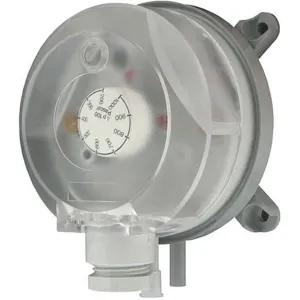The Dwyer ADPS Series adjustable differential pressure switches are general-purpose, airflow-proving switches designed for HVAC and building automation applications. The ADPS Series can be used to sense positive, negative, or differential air pressure. The silicone diaphragm and calibration spring are housed in a rugged plastic enclosure with a removable cover protecting the set point adjustment knob and snap action switch terminals. Electrical connections are made through a 7/8 in diameter opening in the cover that accepts a 1/2 in conduit connection. Air sampling connections accept 1/4 in ID tubing.
Features:
- This Dwyer differential pressure switch has an SPDT switch consisting of one input and two output terminals.
- Its dual-scaled adjustment knob helps to change the switching pressure & eliminates the need for a pressure gauge.
- This rugged switch can be mounted vertically with a pressure connection pointing downwards for maximum security.
- It features a PA 6.6 body for low moisture absorption and a silicon diaphragm for chemical resistance.
- This Dwyer pressure switch can handle maximum temperature and pressure ratings of 185 degrees F and 40 in w.c (10 kPa), respectively.
Compatible Accessories:
- Dwyer Static Pressure Tip: It is designed for use with gauges, controllers and pressure switches for monitoring static pressure drop across cooling coils, discharge pressures & blower inputs.
Standards and Approvals:
Frequently Asked Questions:
Q. What is differential pressure?
A. Differential pressure is defined as the difference in pressure between two given points. It can be measured by using differential pressure sensors to detect increase / decrease of pressure inside a system.
Q. What does PA stand for?
A. PA 6.6 is a type of polyamide that provides high impact strength, stiffness, low density and high thermal stability.
Q. What is a NEMA 13 enclosure rating?
A. NEMA 13 enclosure protects against accidental contact with hazardous or sensitive parts and ingress of circulating foreign matter, such as dust, dirt or splashing / dripping water. It also resists the entry of non-corrosive oil and coolant.
Q. What is the significance of the drainable blade type?
A. The drainable blade type prevents water from accumulating, ensuring effective rainwater management and preventing potential damage caused by water infiltration.



